If only. My smattering of Japanese is barely adequate for ordering a meal and getting back to the hotel afterwards, let alone reading one of the most subtle and enigmatic poets of all time. Factor in the spiritual, cultural and historical differences between myself and an itinerant 17th century Japanese poet, and I’ve got about as much chance of reading the original Basho as I have of solving the Zen koan about the sound of one hand clapping.
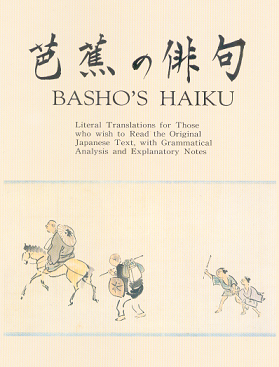
Translations obviously help, but they’re a bit of a tease. However much I enjoy a particular English version of a poem, at the back of my mind I’m always wondering “How close is this to the original? Did he really write ‘perfume’ or was it more like ‘a nice smell’?”. And so on.
Which is why it was so exciting to come across Toshiharu Oseko’s Basho’s Haiku in a Tokyo bookshop earlier this year. It was the subtitle that drew me in:
I was certainly one of “Those who wish to Read the Original Japanese Text”, and the prospect of being able to do so without undertaking the arduous labour of learning Edo-period Japanese and the attendant literary history was frankly appealing. But how could this be possible?
The simplest way to explain what Oseko has done with Basho is to show you some excerpts from a page of his book. The book presents 330 of the thousand or so known haiku of Basho, each in the same format on a separate page.
At the top of the page is the original Japanese version of the poem. Don’t worry if you can’t read the characters (I can’t read all of them) – what do you notice? Take a moment to register your impression before reading on.

For me, the most obvious and surprising thing was that it’s written as a single line. What happened to the haiku made of “three lines of 5-7-5 syllables” we were told about at school? When I asked a Japanese friend she told me haiku are often (though not always) written like this – sometimes the ‘lines’ are divided up on the page, but often the divisions are just inferred by the reader who recognises the form. And like most Japanese script, the poem can be written either horizontally (from left to right) or vertically (from top to bottom). This is all very different from English versification, where the line breaks are what distinguishes verse from prose, and where the layout of a poem on the page is practically set in stone.
Having plunged us in at the deep end, Oseko throws us a life-belt, by following the Japanese script with a literal English translation of the poem:
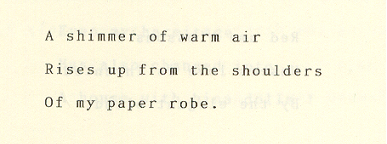
And there it is. Right in front of us, with photographic clarity – a moment of life. The cultural and historical barriers have melted away and we are in the room with the poet, sensing his body-heat and sharing his quiet delight in the shimmering air.
I almost feel there’s nothing more to say about this translation, such is its excellence and economy as a poem in its own right. These virtues are clearly the result of Oseko’s determination “to translate the text as literally as possible”, and reduce the interference of the translator to the bare minimum.
But even given Oseko’s stated intentions, and the quality of the finished result, we are still faced with a gap, between the impenetrable Japanese script and the clarity of the English translation. How does he bridge this gap? In three stages.
The first stage is to help us hear the sound of the Japanese words, by transcribing the original script into Roman characters:
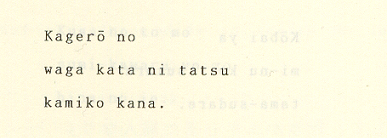
Try reading this aloud, bearing in mind a couple of points: Japanese is relatively easy to pronounce for English speakers, since the vowels and consonants are pronounced more or less as we would read them; slightly more difficult is the fact that there is very little variation in the relative stress of syllables, unlike English. Thus “kamiko” is not pronounce “kamiko” or “kamiko” but “kamiko”, without stressing any syllable more than the others. Try it.
Well, I can’t pretend to have much of a feel for the rhythm and sound patterns of the original, but there is at least a frisson of pleasure in approximating the sound of the words that passed Basho’s lips. We have taken our first step across Oseko’s bridge.
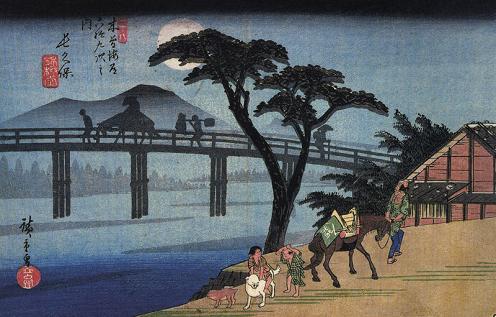
Now for the second stage – and this is where the real magic begins. For after the phonetic transcription, Oseko has painstakingly described the meaning and grammatical function of every single word in the poem! Here is his gloss for the first line:
Kagero no
kagero: heat haze, heat waves, shimmering of heated air
no = ga: a subjective particle
So now we know that the phrase “A shimmer of warm air” is a translation of the single word “kagero”. We have taken another step across Oseko’s bridge. By giving us three supplementary translations, he makes it clear exactly what the word refers to. The word “no” might trip up a novice student like me, since in modern Japanese it usually indicates possession, but Oseko explains that it is equivalent to modern “ga”, which indicates that “kagero” is the subject of the sentence. (Particles are the “small change” of the Japanese language, a bit like our conjunctions, prepositions and articles.)
Now for the next line:
waga kata ni tatsu
waga: my
kata: a shoulder(s)
ni: a particle meaning: at, on, from
tatsu […]: to stand, rise
We are nearing the apex of the bridge, and the far side is coming into view.
And the last line:
kamiko kana
kamiko: a paper robe (garment, clothes) for protection against the cold
For the meaning of “kana” we have to turn to Oseko’s excellent introduction, where he explains that it is an old-fashioned poetic word which “indicates the end of a sentence adding the meaning of interrogation, prohibition, wish, exclamation, emphasis, etc.”.
The third and final stage of Oseko’s bridge is composed of notes explaining some of the cultural and social references in the poem, often including quotations from Basho’s prose or well-known commentators on his poetry. In this instance, we learn that this poem was composed on the occasion of a poetry party with Basho’s disciples “Tanzan, Sora, Shikin, Ranran and two others at Tanzan’s inn in Angaki on Feb. 7, 1689”.
So have we reached the other side? Not quite. Oseko’s patient guidance brings us tantalisingly close to Basho’s original haiku, but for a non-native speaker they are probably destined to recede further into the distance the closer we approach. As if the bridge were shaped like an asymptotic curve, forever approaching the far riverbank but never quite touching it.
Having said that, Oseko has brought me much closer to Basho’s work than I ever expected to get, and for that I’m profoundly grateful. This is the kind of ‘ideal book’ I would want to have for every major poet in a foreign language. But I’m unlikely to get it for practical reasons. To put it bluntly, it’s relatively easy to undertake a project like this for Basho, as he wrote such short poems – yet it’s still such a mammoth task that took huge dedication from Oseko to complete it.
How did he do it? Folded inside the book I found an article from The Japan Times (11th April 1991) that told the story of the book’s genesis:
Oseko’s career as a veteran tour guide of the Japan Travel Bureau gave him the opportunity to travel to places which Basho himself visited. At each place he would recite one of Basho’s haiku and explain to the foreign tourists the historical and cultural episodes behind the poems.
“Some places need a deeper explanation. I always regretted that there was only five or 10 minutes to explain things,” says Oseko.
In his new book he has fulfilled his dream of explaining Basho’s work to his heart’s content…
Oseko spent seven years writing the book, which he published at his own expense. He would wake up every morning at 4 a.m. and work on his word processor before leaving for the office. Aside from suggestions and advice from his acquaintances, Oseko did everything on his own.
In other words, it was a labour of love. For me, this story makes the book all the more compelling. It was written by a man with a living to earn, without the contemplative license of an academic stipend, who chose to put poetry at the heart of his work, and to share his enthusiasm for the Master with people who may never have read poetry at all. And I’m sure many of his tourist customers were as captivated by his enthusiasm as I have been.
An unexpected effect of the book was that I found myself itching to play around in Oseko’s workshop and try my hand at some translations myself. It’s ridiculously naive I know, a bit like watching a master watchmaker take an antique miniature watch apart and put it back together – he makes it look so easy, you start to think “I want to have a go…”.
So I started playing a game with myself, to see if I could improve upon any of the translations in the book, more as a reading exercise than a writing one; working on my own version of a poem forced me to go back and re-read through Oseko’s text very carefully, and notice things I had missed before. And I found it very difficult to add to (or take away from) Oseko’s versions. For example, returning to the poem we have just considered, I thought there might be a case for substituting “ripple” for “shimmer”, to remove the “shiny” connotations of the latter, and stay focused on the actual appearance of the little heat waves:
A ripple of warm air
rises up from the shoulders
of my paper robe.
And in the spirit of the evident economy of the original, we can probably lose “up” from “rises up”, and possibly “warm” from “warm air” (since the warmth is evident from the rippling and rising), leaving us with:
A ripple of air
rises from the shoulders
of my paper robe.
But this is mere tinkering, and we have not gone very far from the version in the book before I run out of suggestions. However, it was still a heady experience for me to be standing on the shoulders of such giants as Basho and Oseko, and I feel it has brought me a little closer to the poem. Another step across the bridge, perhaps.
In other cases, in spite of my impertinence I was left scratching my head and unable to think of any way to improve upon Oseko’s version. Such as the famous frog poem:
An old pond,
A frog jumps in,
The sound of water.
Faced with this translation alone, I might be tempted to substitute “splash” for “the sound of water”, but the notes make it clear that the original “mizu no oto” uses three words, and that the “sound” (“oto”) and “water” (“mizu”) are separate words. This and many other examples in the book have convinced me of the essential validity of Oseko’s approach to translating Basho: trying to be as literal as possible, without introducing Western poetic conventions, such as reproducing the 5-7-5 pattern in English syllables or (perish the thought) adding rhyme. An interesting footnote on this poem points out that the original Japanese admits the reading “frogs jump in”, since plurals are not indicated in Japanese as unambiguously as they are in English.
So there I was in the Tokyo bookshop, weighing up the book – literally. It’s a handsomely produced hardback and quite heavy, and I was conscious that we were already nearing the limit of our luggage allowance for the flight back. But there was no decision to make, I had to have it. I was even willing to sacrifice one of my bottles of sake if necessary – fortunately it wasn’t.
And now for the bad news – I’ve been trying to find somewhere you can order this wonderful book online, so far without success. I’ll keep trying but if anyone can suggest a source I’d be very grateful and will add it to this post.
The good news is that Oseko has produced a second volume of Basho, which I have yet to sample, so I’m not likely to run out of poems in this lifetime.
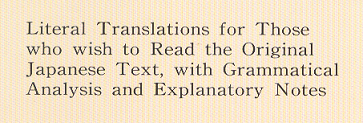
Glad to have found you Mark.
I had a very similar experience in coming around to blogging….
I think there are some good poetry blogs out there, but it depends what you like. The best way to find them is to click on links you find in blogs you like, which is how I found your blog -through Todd Swift’s.
Thanks guys, sorry your comments have been shunted onto the wrong post, I’m trying to fix that…
Hi Mark, I’m gradually gathering poetry blogs I find inspiring, but it can become quite time consuming! An interesting US blog is Ron Silliman’s at http://www.ronsilliman.blogspot.com/
i am working on some new paintings and am in need of the original japanese characters for bashos
year by year
the monkeys mask
reveals the monkey
Sorry Matthew, I’ve had a look through the book but can’t see that poem in it. It’s a big book so I might have missed it, I’ll let you know if I find it.
Hi Mark, small world… Came across this searching for a good translation of “Narrow Road to the Deep North”.
Don’t think I’ve sufficient enthusiasm to try the level of detail given here, especially as haven’t remotest knowledge of Japanese, but I did enjoy your exposition.
Cheers, Pat
Thanks Pat, glad you enjoyed it. Small world indeed!
Dear,
I am in search to buy me TOSHIHARU OSEKO’s book
BASHO HAIKUS
Kind regards
Geert Verbeke
Hi Geert,
Sorry, I’ve still not found anywhere to order the book.
Hello
If you’re still looking for a copy of “Basho’s Haiku: Literal Translations for Those Who Wish to Read the Original Japanese Text” by Oseko, there’s a used copy for sale on Amazon.com as of June 2008.
Warm regards,
H. Gordon
Thanks Gordon, I’ve got my copy but hopefully that will be of interest to someone else…
Does anyone know where i can get a copy? My friend’s in love with everything about Japan and this would be the PERFECT gift
Thanks
And there is what some alternative? 😉
Becky — sorry, I’ve only come across it in the bookshop in Tokyo.
Zinovy — ??
Great review, Mark!
I realize this is 14 years late, but there’s a pdf of Oseko’s book here at this wonderful site:
https://www.thehaikufoundation.org/omeka/items/show/208
By the way, for those intimidated by all the apparatus, don’t be: it’s easy to skim the text from poem to poem, just looking at the translations and as much of the vocabulary notes as you wish. Just skip anything (grammar terminology etc.) that’s incomprehensible. On the other hand, if you want to learn just enough Japanese to read haiku in the original, no better place to start. It won’t waste your time telling you the proper polite form to address a middle management bureaucrat etc.
That’s just an instance of the thoughtfulness of this very appealing writer. As a retired ESL teacher in Japan, I think he handled the cultural knowledge and expectations of his readership beautifully. Sometimes his enthusiasm runs away with him, but that’s part of the book’s charm.
Mark, how did it work out after all these years?
Bill Lee- 14 years after, but perfect timing for me. Thank you so much for the link to the PDF. Just what I need for a music/haiku project. 🙏 Happy reading!